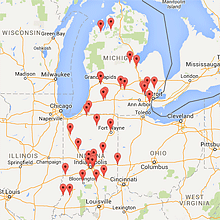
If you own or operate heavy equipment that depends on tracks, you know that your undercarriage is a critical part of your equipment. Crawling equipment is complex, and it’s built to withstand harsh and heavy conditions. However, no equipment lasts forever. The effort you spend on undercarriage maintenance and care will pay off enormously in extended component life and continued working time.
Jump to Sections:
- Selecting The Right Tracks
- Factors Affecting Undercarriage Wear
- Proper Track Operation
- Daily Undercarriage Inspections
- Adjusting Track Tension
- Cleaning Undercarriages
- Track & Shoe Size
- Undercarriage Preventive Maintenance
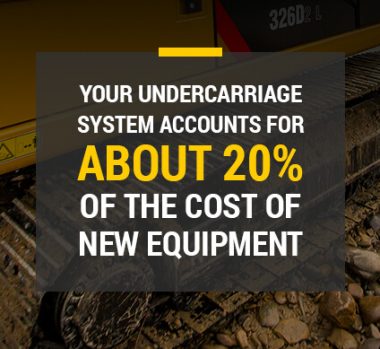 Heavy equipment that crawls on tracks is a large and important investment. Your undercarriage system accounts for about 20% of the cost of new equipment. In contrast, your undercarriage accounts for around 50% of your maintenance budget. To get the most of your equipment investment, proper undercarriage preventative maintenance is essential.
Heavy equipment that crawls on tracks is a large and important investment. Your undercarriage system accounts for about 20% of the cost of new equipment. In contrast, your undercarriage accounts for around 50% of your maintenance budget. To get the most of your equipment investment, proper undercarriage preventative maintenance is essential.
There’s more to undercarriage maintenance than performing a routine undercarriage inspection. The two primary undercarriage management principles are keep it clean and maintain the appropriate tension. Beyond these key points, there are a number of factors that can impact the wear of your equipment over time, including your application, the terrain, operator techniques and using the right tracks for your job.
Select the Right Tracks for Your Work
Earthmoving equipment technology continues to advance and evolve. Today’s equipment is much more dependable and durable than excavators, dozers and compact track loaders of the past. Now you have an excellent selection of track options, and the key to a successful operation is selecting the right ones for your unique needs.
There is no such thing as a universal track, because the conditions where you operate your equipment can vary widely. You’ll experience everything from soft sand or muck to track-chewing rock and demolition debris.
Engineers design equipment tracks to displace weight effectively. Track-equipped equipment has a far smaller footprint or a lower ground pressure than wheeled equipment, and they also have more traction. However, tracks can be hard on some surfaces, and this is why leading equipment manufacturers like Caterpillar let you select from these two track material options:
- Steel tracks: Most large equipment like hydraulic excavators and dozers use steel track for propulsion, traction and stability. There’s no substitute for metal tracks when it comes to durability. Steel is strong and long-lasting. However, steel tracks can tear up your work surfaces and cause damage. Metal pads with steel grousers are made to cut into the ground so they can propel your equipment and let it do what it’s designed for. If you have more sensitive applications, you may want to look at the rubber alternative.
- Rubber tracks: You’ll rarely find rubber tracks on large-scale equipment. Rubber is a highly flexible material, and it can be tough when necessary. However, there’s a limit to what you can expect rubber tracks to support. If you’re working on soft ground like turf or finished surfaces like concrete, you’re wise to select rubber tracks. You’ll still have great support and control, but you won’t be as prone to collateral damage. Rubber tracks are ideal for small-sized excavators and compact track loaders where you need a light footprint.
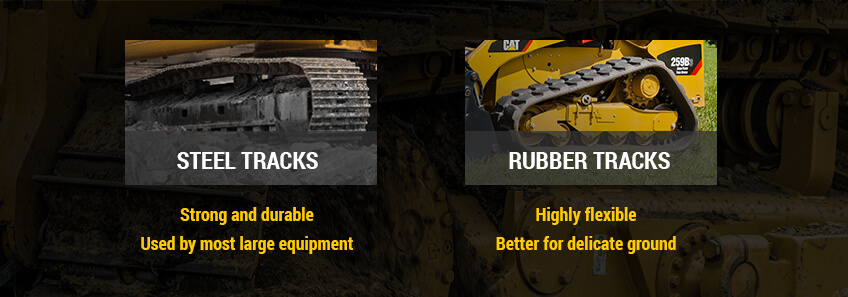
Whether you’re running on rubber or steel, you’re still going to have the vital undercarriage support you need. Your undercarriage components let you crawl, turn and stay upright. They also give your tracks alignment and the right amount of tension balance to let your equipment work without fail.
While your steel or rubber tracks might be reliable within their designed life span, your undercarriage is always vulnerable. The undercarriage is a complicated system of moving parts, and it requires special attention to prevent failure. Undercarriage failure can be catastrophic and very expensive to repair.
Preventing failure is what your undercarriage maintenance program is all about. You must pay close attention to your undercarriage parts as well as what your tracks tell you. An important part of your program is understanding the factors affecting undercarriage wear and what you can do to prevent premature wear-out.
Factors Affecting Undercarriage Wear
All undercarriage components naturally wear out over time, and they have limited service expectancy.
Undercarriage wear doesn’t have a specific time limit. Although you measure service life in operating hours, there is no set rate for how long your equipment’s undercarriage will last. Component lifespan greatly depends on a variety of factors you’ll experience on your job sites. Here are the main factors affecting undercarriage wear:
- Application: This factor refers to the type of job you are using your equipment to complete. Applications have an enormous impact on the stress and strain placed on your parts. Typical site applications include excavating or trenching, dozing or pushing, ripping, loading, carrying and grading. Some applications place more strain on your undercarriage than others. The key factor is the torque transferred from your power component through your drive system. As a rule, the more torque required for the job, the more wear you’ll place on your undercarriage.
- Terrain: You can rarely control the terrain your equipment faces. Usually, your equipment is there to change the terrain. It has to work within preset conditions, and some of those conditions can test your undercarriage limits. Terrain wear on your undercarriage comes from working on hills, slopes, crowns and depressions. It’s the resistance force your undercarriage experiences from changing terrain that can really wear your components.
- Underfoot: Along with challenging terrain is the underfoot conditions your undercarriage experiences. Your tracks take the front line of abuse from abrasive rocks and harsh debris. Your tracks then transmit underfoot material into your undercarriage, causing wear. Underfoot conditions like sand might seem soft and easy on your tracks, whether they’re rubber or steel. However, sand is very abrasive, and it grinds away at moving undercarriage parts, causing high wear and shortened life. The trick to undercarriage survival from underfoot threat is constant cleaning.
- Operation: Application, terrain and underfoot conditions aren’t the only threats to your undercarriage. Plenty of wear comes from how your equipment is operated. Aggressive operation is a big factor affecting undercarriage wear.
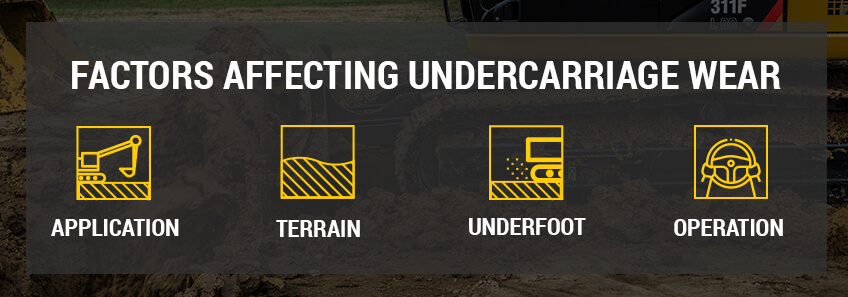
You can easily prevent unnecessary undercarriage wear by training your operators to run equipment responsibly. You can also minimize operator wear by monitoring them. This intervention alone can save you a lot of money in undercarriage upkeep and repair bills.
Proper Track Equipment Operation
Most equipment operators don’t intend to do harm. Operator harm often comes from inexperience or lack of proper training. The main mistakes you’ll find operators making that wear out equipment undercarriages include:
- Operating aggressively to get the job done quickly
- Traveling too fast for site conditions or the designated speed limit
- Placing excavation force on the rear drive sprocket instead of front idlers
- Digging from the equipment’s side and placing cross tension on undercarriages
- Slipping or spinning the tracks in soft underfoot and terrain conditions
- Turning the equipment continuously in one direction and not alternating turns
- Traveling in reverse unnecessarily, which places wrong-directional force on drives
- Operating on grades and slopes instead of leveling equipment to equalize force
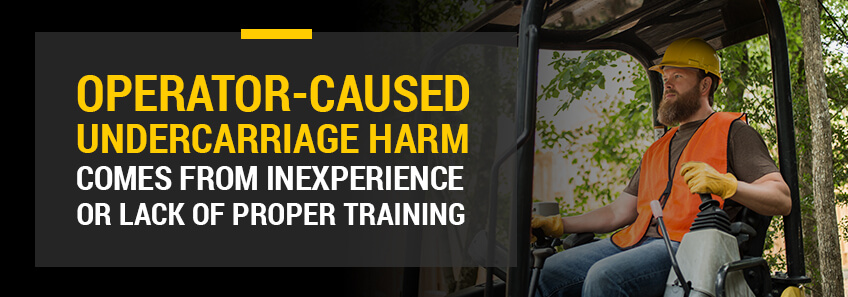
Every movement your undercarriage makes causes some wear on the components. But even though parts are expected to wear and be replaced, it doesn’t mean you can’t take steps to prolong their lifespans. The effort you put into educating your operators and having them become part of your undercarriage maintenance program will reward you. One of the main steps your people can take is to perform daily undercarriage inspections.
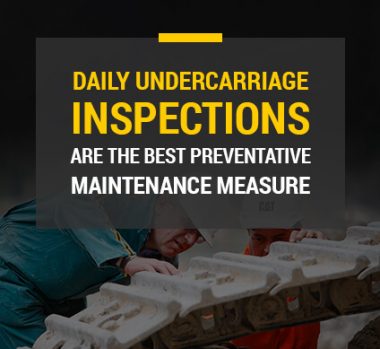 Daily Undercarriage Inspections
Daily Undercarriage Inspections
If your equipment operators have a personal stake in your fleet, they’re much more likely to treat it right. They’ll pay attention to proper operating procedures like avoiding side-stress on undercarriages and not placing excavation force on your rear drives. They’ll travel at sufficient speeds to work productively but slow enough to save wear on components.
Your operators are the closest to your equipment, and they’re excellent sources for early warnings when trouble begins to happen. Encourage your operators to report potential problems immediately. Chances are they’ve usually spotted the issue though a daily undercarriage inspection.
Performing daily undercarriage inspections is one of the best preventive maintenance measures your team can take. Inspections don’t take much time, but they have long-term payoffs. Here are the main points to check when you’re doing a daily undercarriage inspection:
- Stand back and have a general look to identify anything that appears out of place.
- Walk a circle around your equipment before looking at individual parts.
- Look for oil leakage or any unnatural wetness that may be dripping down.
- Give a further look to leaking seals or damaged grease fittings.
- Check sprockets for teeth wear and bolts that are backing off.
- Inspect your idlers, guide plates, rollers and links for loose or missing parts.
- Watch your undercarriage frames for signs of stress cracking.
- Check the undercarriage rails and look for indentation wear.
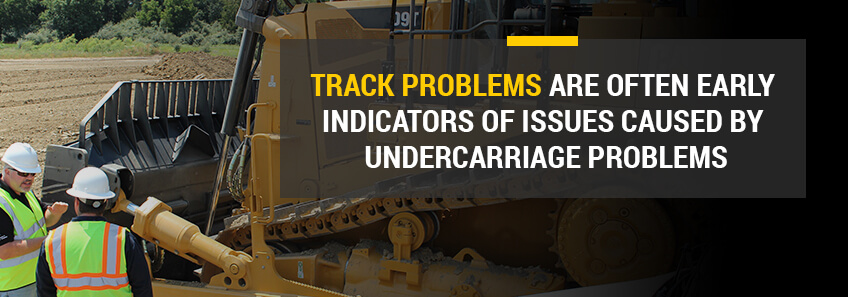
Your undercarriage isn’t the only part of your equipment to check in a daily inspection. Your tracks are also important to keep an eye on. Track problems are often early indicators of issues caused by undercarriage problems. Here’s what to inspect on your tracks daily:
- Correct any cracked, broken or loose shoes and replace missing shoes immediately.
- Check for track tension and follow the tolerances set in your equipment manual.
- Watch for track alignment that shows an inward or outward travel tendency.
- Inspect shoe wear on leading and trailing edges as well as traction bar wearing.
- Start your equipment and slowly spin each track while monitoring performance.
- Look for any cracking or fraying if you have rubber tracks.
- Examine steel tracks for corrosion or metal fatigue.
Your tracks have an enormous influence on your overall undercarriage performance. Most equipment manufacturers and operators consider tracks a slightly separate entity from true undercarriage components like sprockets, drives, links, rollers and idlers. Both tracks and undercarriage assemblies are technically separate systems, but each one supports the other.
Whether you have rubber or steel tracks, they need daily inspections and proper maintenance. Your undercarriage needs low wear and freely moving parts to perform well, and that starts with making sure you adjust the track tension.
Adjusting Track Tension
Having the right track tension is critical for long-lasting life in your undercarriage system. Track tension needs to be a perfect balance of not-too-tight and not-too-loose. This can be tricky to achieve, and proper track tension depends on certain factors.
If your tracks are tight, they’ll place unnecessary resistance on all your undercarriage components. Every moving and stationary part of your undercarriage will be stressed. That leads to early wear and costly repairs.
If your tracks are too loose, they’ll also place stress on your undercarriage. Loose tracks will wander and go out of alignment, placing side stresses on your system. As with being too tight, loose tracks wear out your undercarriage and can cost you.
Setting the right track tension depends on a variety of factors. Track tension is a matter of specific equipment design, individual track type and actual working conditions. These are the main factors concerning track tension:
- Track type: Steel or rubber manufacturing materials
- Equipment size: Large hydraulic excavator or small multi terrain loader
- Underfoot conditions: Soft sand or hard rock terrain
- Environmental influences: High or low temperatures and seasonal variances
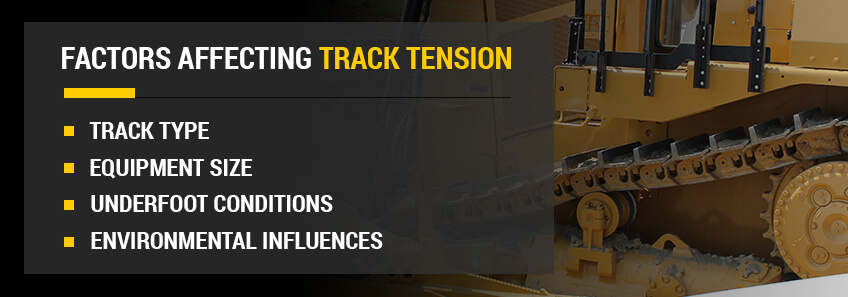
Setting your track tension to get the best performance from your undercarriage can be an art of its own. Track tension is equipment-specific but it has an important influence on your undercarriage wear. The best step you can take is referring to your original equipment manufacturer’s manual like those that come with your Cat® equipment.
You’ll likely come across the word “sag” when you’re investigating how to set your track tension. Sag is the dip or drop you’ll see in your track at the upper plane where it’s not affected by ground compression. Your manufacturer will have a sag guide table that gives ideal tolerances for track tension.
You’ll find a lot of variance in track tension tolerances. Big excavators with standard sprocket designs and large steel tracks have different sag rates than rubber-equipped compact track loaders with elevated sprocket designs. When in doubt about track tensions, always contact your equipment dealer for professional advice.
Professional advice from a reputable dealer will save you a lot of headaches when it comes to undercarriage issues. They know the tension tolerances needed for top performance and will always advise you of the most important rule in undercarriage maintenance — keep it clean.
Cleaning Undercarriages
Cleaning your undercarriage is the simplest and safest way to make your undercarriage last as long as possible. Your undercarriage is a complex system of moving parts that can break down when it gets too dirty. Regular cleaning is undercarriage management 101.
It might take a lot of effort to clean your undercarriage components properly, but it’s worth your time. What cleaning is necessary depends on what application you’ve put your tracked equipment through, what terrain you’ve operated it in and what underfoot conditions you’ve moved your tracks through. What’s deposited into your undercarriage assembly is a by-product of work. It’s also a mess that has to come out.
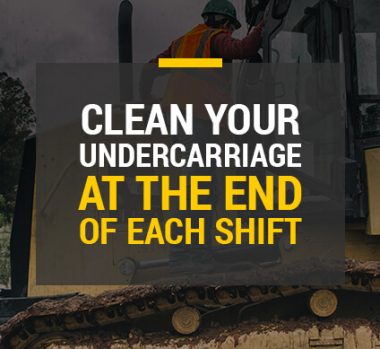 Cleaning your undercarriage is an ongoing event. It’s best to get it done and over with right at the end of each shift. It’s not wise to let a dirty undercarriage sit overnight. In warm weather, gunk can dry and harden. In cold times, it’ll freeze and bind. Either way, it’s going to be a lot harder to clean your undercarriage later than sooner.
Cleaning your undercarriage is an ongoing event. It’s best to get it done and over with right at the end of each shift. It’s not wise to let a dirty undercarriage sit overnight. In warm weather, gunk can dry and harden. In cold times, it’ll freeze and bind. Either way, it’s going to be a lot harder to clean your undercarriage later than sooner.
Dirty undercarriages lead to a number of problems over time. Built-up debris will jam your moving parts and can cause components to snap under protest. Grit also leads to abrasion and premature wear. You’ll also have lower fuel efficiency where there is resistance from clogged tracks and stuck undercarriage parts. Here are some undercarriage cleaning tips to help your preventative maintenance program:
- Use a power washer, if possible, to blast debris from undercarriage parts.
- Use a specially designed track spade to dig out rocks and mud clumps.
- Use a basic hose at the very least to wash components and free-up grit.
- Use compressed air to shoot into your undercarriage assembly.
- Use the track-spinning method to force materials from your equipment centrifugally.
Whatever undercarriage cleaning method you try, make sure you stick with it regularly. Clean undercarriages are long-living assemblies, and they’ll save you a lot of time and money. Cleaning is extremely important for your overall undercarriage preventive maintenance plan.
Track Size and Shoe Importance
It’s always important to bring up track and shoe size when talking about undercarriage maintenance. Having the proper track width and shoe size for your task has a big effect on performance. If your track and shoe combination is oversized, the unnecessary weight and bulk will wear your undercarriage components. If your track and shoe assembly is too small, your flotation rate will suffer, and so will your undercarriage.
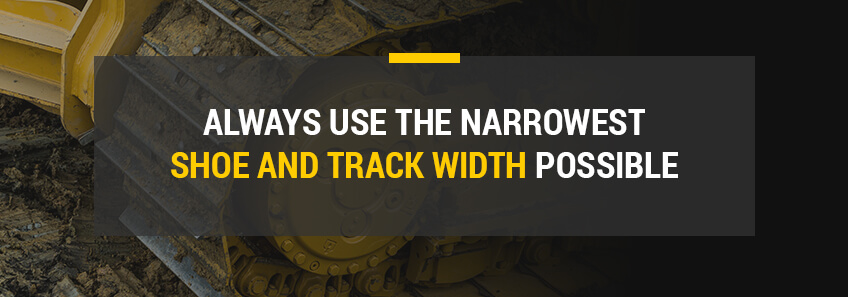
The rule to follow is always to use the narrowest shoe and track width possible. You still want adequate flotation for your terrain and underfoot conditions, but you don’t want to exceed the optimum rate. An oversized track and shoe assembly can cause these undercarriage issues:
- Increased sprocket and busing wear
- Increased wear on flanges, idlers, rollers and links
- Loose pins and shoe hardware
- Track joint life reduction
- Broken shoes and track with failed undercarriage components
Using proper-sized tracks and shoes is an important measure in the fight to keep your undercarriage alive as long as you can. So is keeping your undercarriage clean and always having the proper track tension adjusted for your application. Preventive maintenance is essential for several reasons.
Undercarriage Preventive Maintenance Importance
There are many steps in the undercarriage maintenance process that are essential for ensuring our equipment is at peak performance. Cleaning your undercarriage regularly and adjusting your track tension certainly vital. Lubricating moving parts and replacing components when it’s time are very important as well. Daily inspections also compete for top prevention priority.
Failing to maintain your equipment’s undercarriage is a guarantee to have your equipment fail early. Unfortunately, undercarriages are wear items on all equipment like dozers, excavators and track loaders. But they don’t have to wear out and fail any sooner than necessary.
Undercarriage failure costs are expensive. In addition to repair bills, equipment failures due to poor undercarriage maintenance cost you in job site downtime. They can also cost you in business reputation.
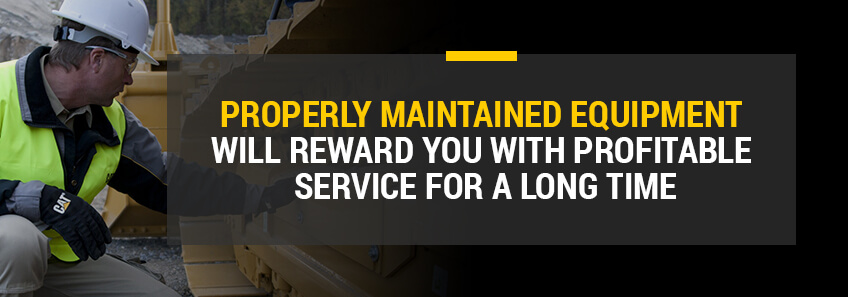
Your reputation, site time and bottom line don’t have to cost you due to undercarriage failure. If you properly maintain your tracked equipment, it will reward you with profitable service for a long time. Consider also partnering with an equipment dealer who knows the value you’ll get with an undercarriage preventive maintenance program.
Video Transcription
Hey, I’m Dave with today’s Quick Tip and I’m here to help you make the most of your investment.
Make inspecting your undercarriage a part of your daily routine.
Look for cracks and damage to the tracks.
Remove excess amounts of dirt and large debris from your undercarriage.
Concrete, rocks and even hardened mud or dirt can increase the fraction your track experiences which will cause wear and may even cause the track to fall off.
Manually extract large items and the occasional power washing will help keep your undercarriage in good shape.
You should also look for loose hardware and oil leaks.
Know the grease points on your specific model.
It is important to grease them daily to lubricate the bushings on your undercarriage frames.
Proper greasing also helps push dirt out.
Tracks should not be too loose or too tight.
Refer to your operation and maintenance manual on the proper tension test procedures for your machine’s specific undercarriage.
Different styles of undercarriage have different tensioning procedures.
The proper track tension will extend the life of your undercarriage.
So remember, for healthy machine undercarriages apply these three simple rules: keep it clean, keep it greased, and keep it tensioned.
Consult your operation and maintenance manuals for more information.
That’s been today’s Quick Tip. Thanks for watching.
Partner With MacAllister Machinery for Undercarriage Maintenance
At MacAllister Machinery, we know how valuable your tracked equipment is. We realize undercarriage maintenance and servicing account for a large chunk of your overall maintenance budget. We want to help you spread your business costs over a long time, and we know that proper undercarriage attention is vital to you.
If your run tracks in Indiana or Michigan’s lower peninsula, partner with MacAllister Machinery for long-term undercarriage management and care. We have the undercarriage service you need to keep your Cat tracks turning and making you a high return on your investment.
Contact MacAllister Machinery today for your undercarriage management solutions. Call us at (317) 545-2151 or contact us online.














